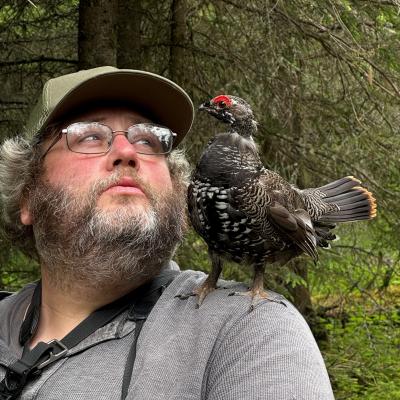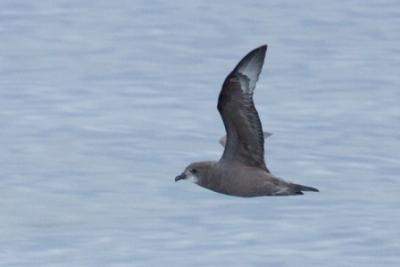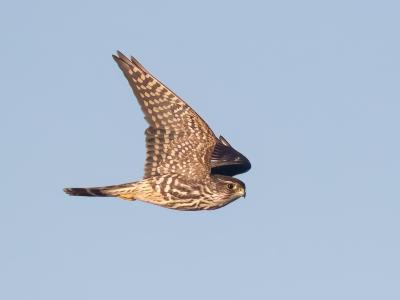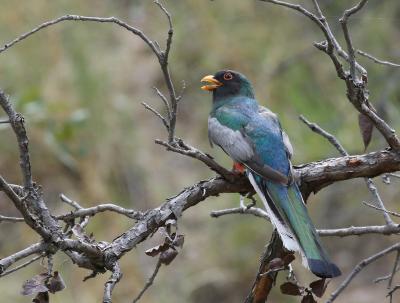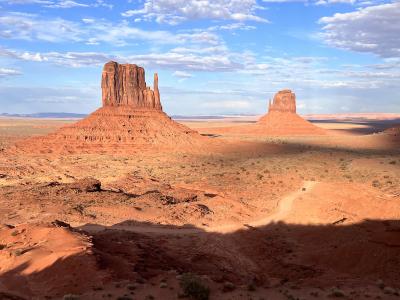Colorado: Lekking Grouse
2026
Single Room Supplement $870
2027
Tour Price to be Determined
2026
Single Room Supplement $870
2027
Tour Price to be Determined
April is a spectacular time of year in Colorado. Late winter and early spring combine stunningly beautiful snowcapped peaks with the first blush of green on the river-edge cottonwoods and prairies. It’s also the time when the five lekking grouse species—Sharp-tailed Grouse, Greater and Gunnison Sage-Grouse, and Lesser and Greater Prairie-Chickens—are engaged in their amazing foot-stomping, cackling, hooting, and/or moaning displays.
Our travels to the grouse leks involve long drives, but what drives! We’ll travel along the Colorado River and the magnificent Black Canyon of the Gunnison, through montane spruce-fir forests and expansive sagebrush flats and grasslands, and past more than a dozen 14,000-foot mountain peaks. Along the way we’ll look for a variety of resident, early-arriving, or late-departing species, including White-tailed Ptarmigan, Dusky Grouse, and all three species of rosy-finch. Mammals will be unusually well represented too: we may see Bighorn Sheep, Pronghorn, Elk, White-tailed and Mule Deer, Moose, Coyote, Red Fox, and, with great luck, Bobcat or even Mountain Lion.
Day 1: The tour begins at 6:00 p.m. at our hotel near Denver International Airport. Night in Denver.
Day 2: We’ll depart early for the foothills outside Denver, where we may see three species of nuthatch, Mountain and Western Bluebirds, and Williamson’s Sapsucker. If the weather cooperates, we’ll make our way to one of the high mountain passes in an attempt to locate the difficult-to-find White-tailed Ptarmigan, still white at this season. During some years rosy-finches linger into April, and occasionally we’re lucky enough to see all three species. In the afternoon we’ll have a few hours’ drive through spectacular mountain scenery before crossing Monarch Pass and dropping into Gunnison. Night in Gunnison.
Day 3: For our first grouse morning we’ll visit a lek of Gunnison Sage-Grouse. This highly localized bird was only recognized as a full species in 2000, and visits to the lek site are strictly regulated. We’ll absorb the ritual dance-displays of these wild looking grouse, and then we’ll head west out of Gunnison to the breathtaking Black Canyon of the Gunnison National Park, where we’ll search for Dusky Grouse, Fox Sparrow, and others. Along the way we’ll pass the Blue Mesa Reservoir, which could harbor Barrow’s Goldeneye and other waterfowl. Night in Gunnison.
Day 4: If we haven’t encountered rosy-finches yet, we’ll head up to nearby Crested Butte where all three species can be found. From there we’ll meander our way east through the mountains, enjoying majestic scenery and stopping to look for Pinyon Jay, Clark’s Nutcracker, American Three-toed Woodpecker, Williamson’s Sapsucker, and others. We’ll then arrive to the Canon City area in search of arid-loving species such as Juniper Titmouse and Rufous-crowned Sparrow. Night in Canon City.
Day 5: We’ll continue the next morning in our explorations of the dry brushlands looking for Scaled Quail, Canyon Towhee, Canyon Wren, and Curve-billed Thrasher before starting a long drive for Kansas. We’ll take a few stops along the way looking for Clark’s and Western Grebes and huge numbers of migrating waterfowl, while impromptu stops could yield migrating Mountain Quail, flocks of Chihuahuan Ravens, or interesting raptors. Night in Hays, Kansas.
Day 6: This morning we will visit a blind for Lesser Prairie-Chicken, a species that has undergone dramatic population declines across its already limited range. We’ll arrive early to the blinds and observe these handsome birds court while being serenaded by Western Meadowlarks. We’ll make our way north for the afternoon enjoying spring unfolding on the prairies. Night in McCook, Nebraska.
Day 7: Thanks to the help of the Red Willow County Visitors Bureau in McCook, we’ll witness sunrise at a Greater Prairie-Chicken lek. We’ll likely hear the eerie calls that accompany the magnificent dance of this species even before we can make them out in the dim light, with the tinkling of Horned Larks in the dark sky above. After the birds have finished displaying, we’ll head west for Fort Collins, taking a short birding break in the renowned and expansive prairies of Pawnee National Grasslands. Night in Fort Collins.
Day 8: We’ll have a flexible morning to look for any rarities in the Fort Collins area before we start to work our way over the mountains to Cameron Pass; we could even return to the Pawnee Grasslands if birding conditions are favorable. Rock Wren, Pygmy Nuthatch, Northern Pygmy-Owl, and American Three-toed Woodpecker are some of the birds we may see along the very scenic drive. Any feeders on the west side of the pass will be our afternoon goal, with rosy-finches, Pine Grosbeak, and Cassin’s Finch all possible. In the mid-afternoon we’ll make the drive to our hotel in Walden. Night in Walden.
Day 9: We’ll rise early to witness the extraordinary display of the largest North American grouse, Greater Sage-Grouse. As we watch the lek, we’ll pay particular attention to the plumage and behavior that distinguish this species from Gunnison Sage-Grouse we observed at the start of the tour. After leaving the lek, we’ll spend the rest of the day exploring the nearby wetlands and sagebrush flats of North Park, where Sage Thrashers might already be in residence. We may see the courtship of newly arrived Cinnamon Teal and American Avocet, and perhaps lingering winter birds like Rough-legged Hawk and Northern Shrike. We’ll also look for Moose as Walden is reputed to be the Moose capital of Colorado. Wolves are also known to be in North Park. Night in Steamboat Springs.
Day 10: We’ll have an early start to search for Sharp-tailed Grouse, one of the more difficult of the “chickens” on this tour. With some luck we’ll witness the wonderful foot-stomping display of this species. If the weather conditions will allow for it, we’ll may want to make another attempt for White-tailed Ptarmigan and any remaining rosy-finches we may still need. Because early spring weather in Colorado can be unpredictable, we may be unable to reach the snowy, high-elevation ptarmigan country; in that event, we’ll spend one last afternoon birding the foothill forests or some of the many fine reservoirs or migrant traps along Colorado’s Front Range. We’ll make our way southeast, arriving in Denver in the late afternoon. Night in Denver.
Day 11: The tour concludes this morning in Denver.
Note: The information presented below has been extracted from our formal General Information for this tour. It covers topics we feel potential registrants may wish to consider before booking space. The complete General Information for this tour will be sent to all tour registrants and of course supplemental information, if needed, is available from the WINGS office.
ENTERING THE UNITED STATES: Non-U.S. citizens will need a valid passport and may need a tourist visa or visa waiver. Please consult your nearest U.S. Embassy or consulate for details. Canadian citizens need to carry proof of citizenship in the form of a passport.
COUNTRY INFORMATION: You can review the U.S. Department of State Country Specific Travel Information here: https://travel.state.gov/content/travel.html. Review foreign travel advice from the UK government here: https://www.gov.uk/foreign-travel-advice and travel advice and advisories from the Government of Canada here: https://travel.gc.ca/travelling/advisories.
PACE OF THE TOUR: This tour involves several early mornings (with 4:30am starts), as viewing the display leks requires waking about two hours BEFORE sunrise for a quick breakfast and a drive to the lek. We’ll view the leks from the van or from controlled blinds and everyone will need to be relatively still and quiet for about two hours. During this time, the van must stay at the lek and people will NOT be able to get out. All of this is essential to reduce disturbance to the birds.
After viewing the birds, we’ll return to the hotel to gather luggage (and a more complete breakfast) and then head toward the next destination, birding along the way. Typically, a day’s driving will total about 225 miles, sometimes on windy mountain roads. These drives will be broken by several birding stops, restroom breaks, etc. Walking will usually be on well-maintained trails or along roads, and will be less than a half mile in duration. We will endeavor to have between 45 and 60 minutes off each day before dinner, but most of the day will be spent in the field.
If the weather cooperates and roads are open, we’ll look for White-tailed Ptarmigan on the first full day. This could involve a short walk on steep and snowy terrain, at an elevation of 12000 feet. People will have the option of staying in the vans.
HEALTH: Colorado has no serious health risks other than altitude.
Altitude: Starting on the first full day of the tour, we’ll be driving up to the highpoint of the tour, just above 12,000 feet. From this point we merely scan from a stationary position, but we may walk a short distance in snowy conditions. Otherwise we’ll be at altitudes from 3000 to 8000 feet throughout. The best defense is to stay hydrated and wear the right clothes (layers) for warmth.
Smoking: Smoking is prohibited in the vehicles or when the group is gathered for meals, checklists, etc. If you are sharing a room with a nonsmoker, please do not smoke in the room. If you smoke in the field, do so well away and downwind from the group. If any location where the group is gathered has a stricter policy than the WINGS policy, that stricter policy will prevail.
CLIMATE: April is a dynamic time of year in Colorado and nearly every type of weather is possible, from heavy snow to clear blue sky and mid-70s (F). It is possible for it to be 70ºF, sunny and calm, only for the temperature to plummet to around 20ºF with heavy snowfall, all in a period of two or three hours! You will need to be prepared for a wide range of weather conditions. Typical highs range in the 50s and 60s (F), with lows in the upper 20s and low 30s (F). Lows in the single digits (F) are rare, but not impossible. Early mornings spent at leks may be particularly cold. Snow is likely; Denver averages about nine inches for all of April. Rain and snow is possible at anytime. Given this, it is very important to dress in layers (see notes below).
ACCOMMODATIONS: We will be staying at standard, comfortable motels and/or lodges throughout the tour. As of 2023 most of our hotels offer free wifi access.
FOOD: We’ll eat in a variety of local restaurants where the food will in most cases be American standard. Some examples include an Italian restaurant in Denver, steakhouse in Gunnison, and Mexican restaurant in Craig, though the quality of Indian restaurants in the high mountains can surprise! Breakfasts are generally taken in our hotels (continental plus), and lunches will be in local or chain sandwich stores or cafes.
WINGS tours are all-inclusive and no refunds can be issued for any tour meals participants choose to skip.
Food Allergies / Requirements: We cannot guarantee that all food allergies can be accommodated at every destination. Participants with significant food allergies or special dietary requirements should bring appropriate foods with them for those times when their needs cannot be met. Announced meal times are always approximate depending on how the day unfolds. Participants who need to eat according to a fixed schedule should bring supplemental food. Please contact the WINGS office if you have any questions.
TRANSPORTATION: We will be traveling by leader-driven 15 [or 12] passenger window van or minivan, depending on the group size. When using 15-passenger window vans, we will take a maximum of seven passengers plus the leader/driver. Participants should be able to ride in any seat in tour vehicles and will be expected to change seats daily.
2024 Narrative
IN BRIEF: Ah.. The dancing chicken tour! A whirlwind adventure over the dramatic mountains of Colorado and out over the plains of Kansas and Nebraska and back again. This annual favorite is certainly an intense tour as we wander the American west, but it is always an enriching experience full of amazing birds and striking mammals, as well as some of the best scenery you can buy in the lower 48! We did well on this run, an earlyish spring had allowed for many spring migrants to have returned to the region, yet winter held on just long enough in the high country that birds like Rosy-Finches were still abundant in multiple spots. We observed all the main grouse lekking grouse targets, and were even able to nab a couple of White-tailed Ptarmigans. In addition to the gallinaceous birds, we had highlights such as Eurasian Wigeon, Barrow’s Goldeneye, Mountain Plover, Pacific Loon, Ferruginous Hawk, Burrowing Owl, American Three-toed Woodpecker, Pinyon Jay and all three species of Rosy-Finch.
IN DETAIL: Our band of adventurers came together in the mile high city of Denver. After our initial meet and greet dinner at a delicious bistro where we could get to know one another before leaping into the vans to spend the next week and half together. The following morning we started at a nearby wildlife refuge, the Rocky Mountain Arsenal. Composed of mostly rolling plains dotted with some low marshy ponds and cottonwood groves, this was an excellent starter morning of birding that we had to drag ourselves away from! The plains were kept grazed down by a resident herd of American Bison acting as a keystone refugia species for a habitat that has largely been altered over the last 150 years. Also plentiful were Black-tailed Prairie Dogs, another vital species to the health of the plains. Although we did not see any, these dog towns provide food and cover for the critically endangered Black-footed Ferret, which is down to handfuls of animals over a few scattered plains states. The ponds were a bonanza for the many species of wintering and migrant waterfowl. Hundreds of ducks were present, most notably Lesser Scaup and Gadwall, but lots of Goldeneye, Mergansers, Northern Shovelers and three species of teal, including the fetching looking Cinnamon Teal were present. In with the Canada Geese was a Greater White-fronted Goose, a rarely seen species on this tour. A flock of migrant White Pelicans flew overhead, and two of the prettiest waterbirds on the prairies were seen side-by-side, both American Avocets and Franklin’s Gulls. In the nearby Cottonwoods, we rustled up some sparrows, including our only Harris’s Sparrow of the tour. Also in the grove was a nesting pair of Great-horned Owls! The raptors had a bit of an uptick in quality as we explored the outer prairie of the refuge where we had a Golden Eagle, multiple Ferruginous Hawks and a Prairie Falcon!
However, every day on this tour is a race against the setting sun and the miles between our destinations would always be a nag to the amazing sightings we had in hand. We began to start our trek up in the high mountains, breaking for lunch in the town of Wildernest. Afterwards we rolled around a fir coated neighborhood looking for feeders. Our quarry was realized when a Brown-capped Rosy-Finch was spotted teed up high in a conifer! This led us to a set of feeders by a welcoming homeowner who allowed us to have a front row seat to the flock of Rosys that were still inhabiting his yard! Numerous other mountain species were present such as Pine Grosbeaks, Steller’s Jays, Mountain Chickadees and the always lovely Cassin’s Finch. We then trekked even higher, to the Loveland Pass at just under 12,000 feet! Here the snow was still exceptionally deep and we were limited to the narrow roadsides as we searched for what felt like an impossible get, that being White-tailed Ptarmigan. Trying to find an all white bird on a snowy expanse felt hopeless so needless to say the uproar that occurred when a participant spotted a couple creeping along the snowfields was momentous! After such a success, the group settled in to complete the long and beautiful drive to the mountain town of Gunnison, where we would make our base for the next two days.
The next day we began our birding by heading westward over the Gunnison Plateau to the Black Canyon National Park. As we drove into the park, a little flurry of birds caught our eye so we pulled over and were pleasantly surprised to have a flock of Pinyon Jays along with a Woodhouse’s Scrub-Jay and some Western Bluebirds. This was fortuitous as we would not see any more Pinyon Jays on our travels. We arrived at the dramatic Black Canyon overlook, truly an amazing chasm into the earth rivaling the Grand Canyon in awe. Less forthcoming was a Sooty Grouse that we were targeting, but the amazing scenery along with a bonus Slate-colored Fox Sparrow was well received. Driving out, we were again treated to a great flock of mixed birds, Clark’s Nutcrackers, both Western and Mountain Bluebirds, Bushtits and a shockingly large flock of Red-breasted Nuthatches. After lunch, we headed back to the Plateau where we had multiple Golden and Bald Eagles and a plethora of Mountain Bluebirds.
The following day was our first lek day! We got up early and headed out to a willow flat where a modified trailer had been set up so we could witness the ancient ritual of the endangered Gunnison Sage-Grouse gathering and display to attract a mate. Due to their endangered status, precautions are high for these birds, and the blind is distant from the actual lek. Still, it is thrilling to see these birds with their spiky tails strutting around. With a scope one can see the longer flowing black crest that separates the species from its look-alike Greater Sage-Grouse. As the sun got higher over the sagebrush clad hills, the grouse slowly departed and eventually it was ok to leave the blind and head back to town for a well-earned hearty breakfast! Packing up our gear, we then started to head up the mountain to the ski-town of Crested Butte to try to see if we could expand upon our Rosy-Finch diversity. A bit of driving around the neighborhoods paid off as it had before, and we found a huge flock of Rosy-Finches, over 200 birds! Most were the expected species of Brown-capped, but we also plucked out a couple of Black Rosy’s and a good handful of Gray-crowned Rosy’s, with two subspecies represented, the interior race, and the silver-naped northern Hepburn’s race. On our way back down the mountain, in addition to a pair of Coyotes and a herd of cooperative Bighorn Sheep, we stopped at a bridge over a rushing stream where we got our first American Dipper of the tour. And as we rolled out off the plateau we made a stab for a Sage Thrasher and were elated to actually rustle up a pair! We made a few stops along the mountain passes as we headed eastward for Three-toed Woodpecker, but here our luck seemed to have turned for the moment. However, in the town of Buena Vista we stopped at a small lake where we had a pair of Barrow’s Goldeneyes side-by-side with some Common Goldeneye making for an excellent study. And at another stop along a river, another pair comparison was made between Say’s and Eastern Phoebes. A real treat was the finding of an active Dipper nest under a bridge along this flowing river.
On our fourth day, we awoke in Canon City, near our furthest points south. Here the bird life took on a distinct flavor of the southwestern deserts; this was immediately apparent as we were loading the vans and had a Chihuahuan Raven fly right over us. An attempt for Scaled Quail at a community brush drop-off wasn’t successful but we did have excellent looks at Curve-billed Thrashers and Canyon Towhees at this spot. At a hiking trail trailhead up some dramatic red rocks, we were treated to quite the display of courting Rock Wrens that made for quite the show. More Chihuahuan Ravens and a Peregrine Falcon were also present here. We then made our way over to the Pueblo Reservoir, a large flooding along the Arkansas River. Landbirds were restricted to handfuls of Horned Larks, Loggerhead Shrikes and a few other common species, but as it was a massive body of water we did quite well for waterbirds. A couple hundred large grebes were on the lake, most too far to identify to species, but the ones we did were Western Grebes. Pods of the much smaller Eared Grebes were present, and there were lots of Bufflehead and Scaup present. A handful of Common Loons were present and a few of us were able to pluck out a winter plumage Pacific Loon before it disappeared in the waves. With a strong wind starting to pick up we broke for lunch and continued our travels east towards Kansas. We made a few stops along the way looking for open prairie birds. The countryside was chock full of Horned Larks and Western Meadowlarks. At a prairie dog town, we spotted our only Burrowing Owl of the trip, and at another spot flushed up a few Lark Buntings, a common plains species but definitely a few weeks ahead of their typical arrival schedule. A pair of distant Mountain Plovers spotted in a distant field left a lot to be desired. However, an exceptionally close Ferruginous Hawk perched near the road made for a fantastic study!
Day five was an exciting one! We arose early to meet a biologist from Kansas Audubon to witness the displays of the critically endangered Lesser Prairie-Chicken. This species has had an incredibly severe decline in its population and central Kansas may be the last stand for this bird. Thankfully, the woman charged with their recovery is an accomplished researcher as well as advocate for the Prairie-Chickens and it was a real treat to hear the results of her studies on this charming grouse. And charmed we were! Small pop-up tents were erected in the dark and then the group huddled into them where we were treated to a front row seat of these engaging birds. Unlike their larger relatives, the male Lessers perform cooperative displays with birds performing their dances in unison, with delightful little explosive popping sounds. There was a lone male Greater Prairie-Chicken present as well as a male hybrid showing and sounding like an intergrade between the two species. Not a lot of other birding was accomplished this day as the windy conditions from the day before had blown up into a full-on gale. We decided to just do our lengthy drive to McCook Nebraska and have ourselves an early night.
The recovery program for the Greater Prairie-Chicken is thankfully a little more optimistic than that of the Lessers. While they still need unplowed tall-grass prairie, this species is a bit more flexible when it comes to habitat changes and human disturbance. For this lek, we were brought to a private ranch where a long-time rancher has become very devoted to helping protect this species. Settling us into a pair of tricked out livestock trailers, this was a very comfortable way to have a great view of today’s dancing chicken show! Before there was even enough light to see the birds, one could hear their melancholic moaning over the prairie wind. Before long there was enough light to watch the birds begin their dances, a vigorous shuffle punctuated by leaps into the air as they inflated their colored neck air sacs and, unlike the Lessers, got into some pretty rough tumbles with other males. It was a pretty good show, but the winds were again blowing pretty strong and after a while, the birds grew weary of battling the winds.
As we drove back into McCook for breakfast and to check out of our hotel, we passed a foraging flock of blackbirds that had several golden hued male Yellow-headed Blackbirds. We then started the trek back into Colorado. We stopped at a reservoir along the way where there was a large flock of American White Pelicans settling in to take cover from the winds, and very exciting were a trio of Baird’s Sandpipers heading north to their high arctic breeding grounds. Late in the afternoon, we were on the outskirts of the Pawnee Grasslands and were fortunate to encounter a very cooperative pair of Mountain Plovers! This more than made up for the lousy looks we had suffered a few days earlier.
As day seven broke for the tour, we were set to head back into the Rocky Mountains, but first, we wanted to backtrack to the Pawnee Grasslands. The wind, while still present, was finally dying down and we were still missing a vital prairie bird we hoped to connect with. As we slowly tooled along some back country roads, inspecting carefully the flocks of Horned Larks and Vesper Sparrows, we finally found our quarry- the subtly marked Thick-billed Longspur. Close studies allowed us to really appreciate the handsome design of this species and with the bird in the bag so to speak, we could now head off to the high country having seen all the prairie specialties. Traveling up the exceptionally scenic Poudre Canyon we made several stops along the way, as the weather had finally broken and it was a beautiful day to explore the ponderosas along the rushing torrent of the Poudre River. We encountered Golden Eagles at one stop, and for our lunch break, made sure to catch the much-touted full solar eclipse, although we were far enough from totality that we did not experience darkened skies. A stop at a local nature center yielded a flyover adult Northern Goshawk, but most exciting was an extended walk through a closed campground. Here we encountered several nice mountain birds, lots of Pygmy Nuthatches, and several Townsend’s Solitaires. But the real prize was a fetching male American Three-toed Woodpecker that put on quite the show for us!
On our penultimate day of the tour was another early morning, but like all lek mornings, a thrilling experience to be had! We headed out in the dark, dodging White-tailed Jackrabbits along the way, and settled onto a dirt road running along a ridge where we would use our own vans as blinds to view the majestic Greater Sage-Grouse. This glorious beast is a near turkey sized grouse with a dramatic spiked tail, and a pair of ochre-colored inflatable chest air sacs. As the males bounce the sacs up and down and strut about the lek, more and more pheasant-like females would creep along the ground, trying to act as nonchalant as they could as they assessed the fitness of potential males. After the grouse departed the lek, we birded the Walden Reservoir and had a robust flock of several duck species, some American Avocets and a couple new trip birds- California Gull and Black-crowned Night-Heron.
We then headed westward through the Walden Valley and had nice looks at Rough-legged and Swainson’s Hawks. Several herds of Pronghorn Antelope were also observed. We crossed yet another dramatic mountain pass and dropped down into the ski town of Steamboat Springs. Needing to kill a little time before our rooms were ready, we explored some of the neighborhoods of the town where we found a flock of Evening Grosbeaks adorned in bright yellow and white with their explosive calls. After an early dinner, we then set out to start looking for our last two grouse species, Dusky and Sharp-tailed Grouse. We wouldn’t end up finding Dusky’s but we really well for Sharp-tails with nearly 50 birds in multiple flocks. Perhaps just as exciting was the discovery of an adult male Eurasian Wigeon in a flooded farm field with just a handful of other ducks!
The final day of the tour had arrived, and we rose to see if we could watch the Sharp-tailed Grouse doing their wind-up toy dances. While we did see several grouse, none of them had the spirit in them on what was a gray morning and didn’t do any of their dances. We poked around in a few locations trying for Dusky Grouse as we slowly made our way back to Denver, but this species is secretive and certainly the hardest of the grouse to find. We ultimately did not find the species for the 2024 tour, but still enjoyed our last day together as this excellent tour came to an end.
- Skye Haas
Maximum group size seven with one leader or 14 with two leaders.




































